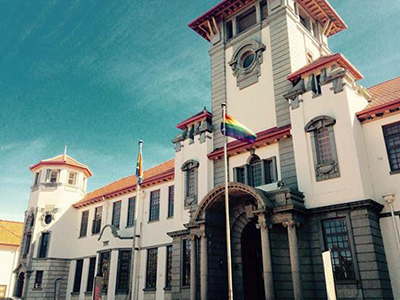Kovsies hoist the rainbow flag to show support for International Day against Homophobia and Transphobia

Photo: Lihlumelo Toyana |
Kovsies reaffirm diverse expressions of love (Facebook video clip)
Transformation is not about black or white anymore, it's about including different diversities (Facebook video clip)
Violence and discrimination against the Lesbian, Gay, Bisexual, Transgender, and Intersex (LGBTI) community is rife in South Africa. Advancing the spirit of the University of the Free State’s (UFS) Human Project, Out@Kovsies and the Institute for Reconciliation and Social Justice (IRSJ) showed their true colours by hoisting the rainbow flag in front of the Main Building on the Bloemfontein Campus.
International Day against Homophobia and Transphobia
This event was in anticipation of International Day against Homophobia and Transphobia celebrated on Sunday 17 May 2015. People across the world, regardless of their sexual orientation, come together annually on this day in support of the LGBTI community. This year, Kovsies became part of that global community when, for the first time in history, the rainbow flag – a popular symbol of LGBTI pride – fluttered high over the Red Square.
Human embrace
Committed to the human embrace, this event was another decisive step towards true transformation. “Transformation is not about black or white anymore,” said Zanele Thela, coordinator and guardian of Out@Kovsies, during the event. “It’s about including different diversities, different sexual orientations.”
Laura-Jane Watkins, research assistant at the IRSJ, said that this day “reflects our attitude as a collective community to embrace difference. Today is a day that we reaffirm diverse expressions of love beyond societal perceptions of gender as an inherent human need and right. Let us now stand together as a student community to promote the value of humanness.”
Rainbow flag
The rainbow flag, also fondly known as the freedom flag, was designed by civil rights activist, Gilbert Baker, and was hoisted publically on 25 June 1978. The modern version of the flag consists of six colours, each with a specific meaning. Red stands for life, orange for healing, yellow depicts sunlight, green stands for nature, blue for serenity, and violet for spirit.
The hope that Thela holds is for everyone to be free to express themselves and their love for one another, because “that’s the one thing we all have in common: love”.